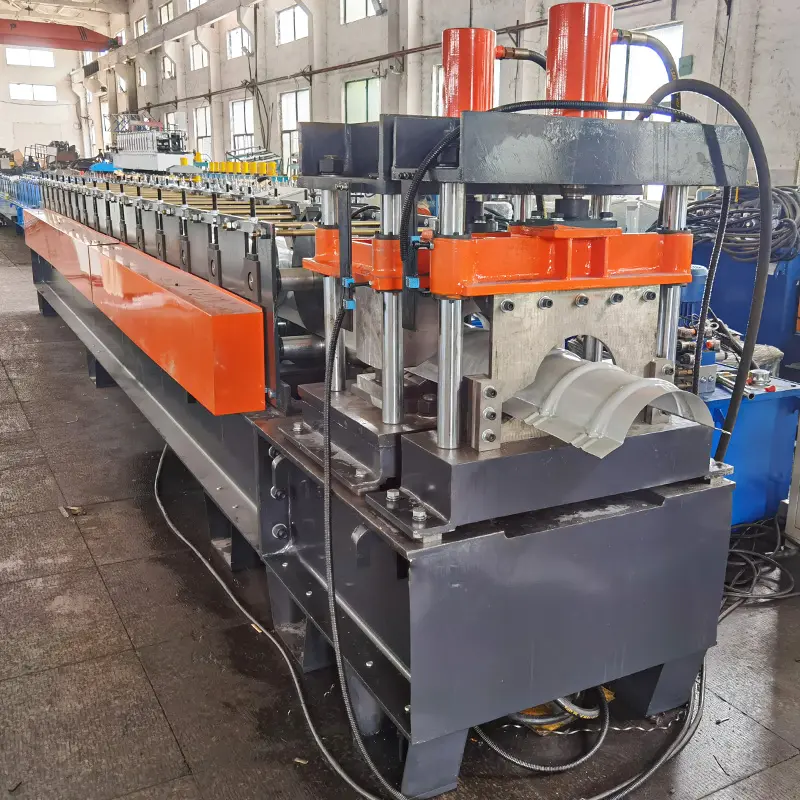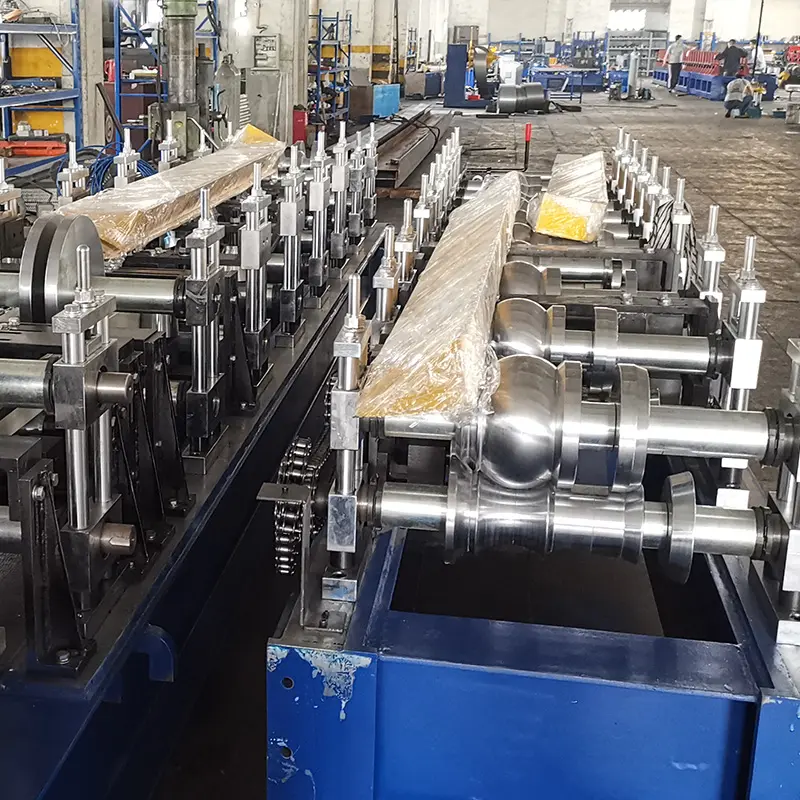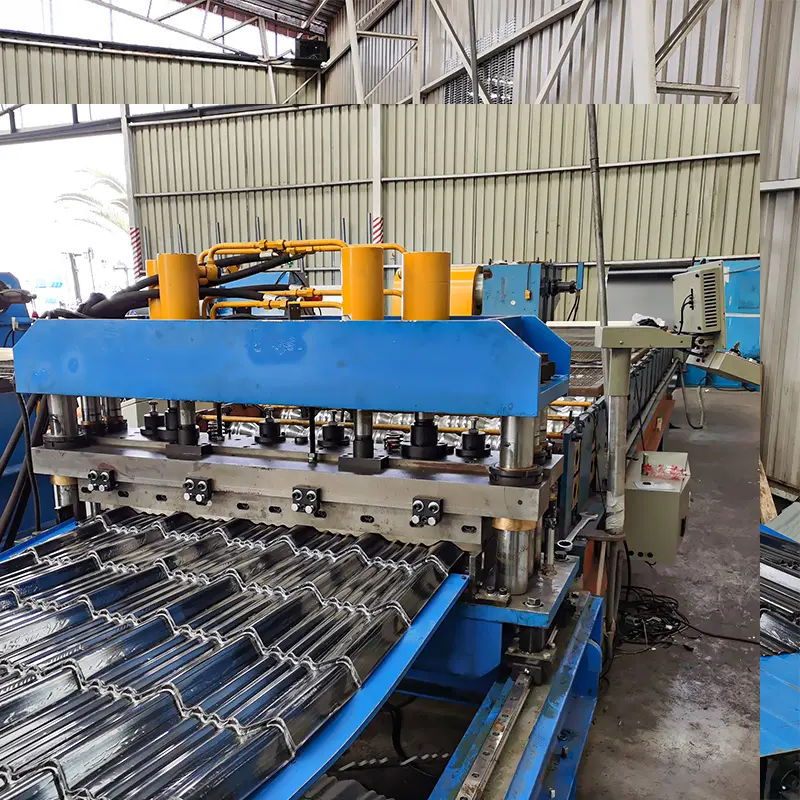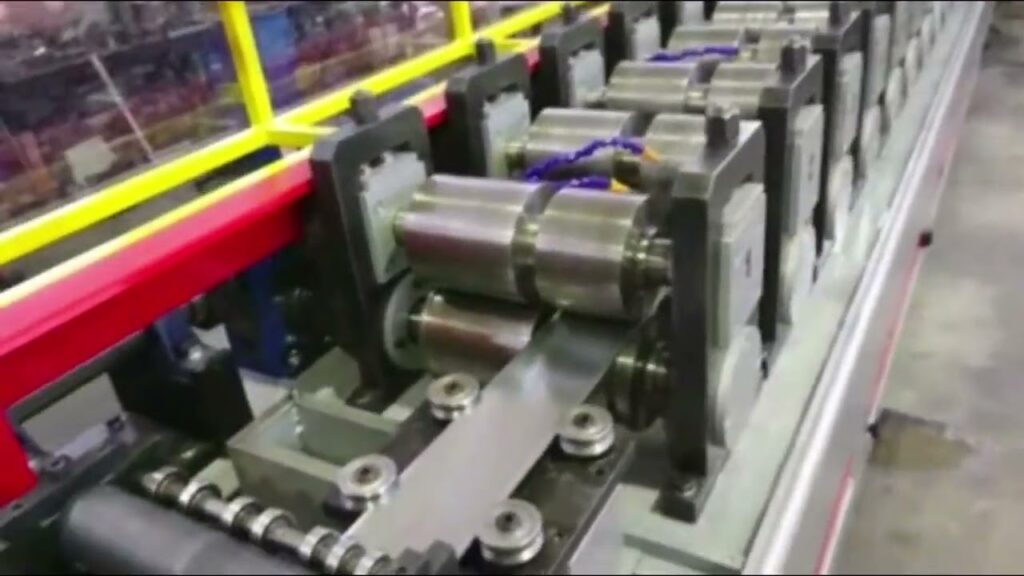परिचय
When it comes to manufacturing high-quality corrugated roof panels efficiently, a corrugated roof roll forming machine plays a vital role. This machine automates the process of shaping metal sheets into corrugated profiles, providing numerous benefits in terms of cost, speed, and precision. In this article, we will explore the features, advantages, working principles, and applications of corrugated roof roll forming machines.
What is a Corrugated Roof Roll Forming Machine?
A corrugated roof roll forming machine is a specialized piece of equipment used in the metalworking industry to produce corrugated roof panels. It is designed to shape metal coils or sheets into uniform corrugated profiles with precise dimensions. The machine operates by feeding the metal material through a series of rollers, which gradually bend and form the material into the desired shape.

Benefits of Using a Corrugated Roof Roll Forming Machine
Using a corrugated roof roll forming machine offers several advantages over traditional manufacturing methods. These benefits include:
- Cost-Effective Production: Roll forming machines allow for continuous and high-volume production, resulting in lower production costs per unit.
- Versatility: Corrugated roof roll forming machines can produce a wide range of corrugated profiles, providing versatility in design and application.
- Increased Efficiency: The automated process of the machine ensures consistent quality, reduces material waste, and improves overall production efficiency.
- Time-Saving: With high-speed operation and quick setup times, corrugated roof roll forming machines can significantly reduce production lead times.
- Customization Options: Advanced machines offer customization features, allowing manufacturers to create corrugated panels of various lengths, thicknesses, and shapes.
Types of Corrugated Roof Roll Forming Machines
Corrugated roof roll forming machines come in different types, each catering to specific production requirements. The common types include:
1. Single-Layer Corrugated Roof Roll Forming Machine
The single-layer corrugated roof roll forming machine is designed to produce single-layer corrugated panels. It is suitable for applications where a single layer of metal is sufficient for roofing or cladding purposes.
2. Double-Layer Corrugated Roof Roll Forming Machine
The double-layer corrugated roof roll forming machine is capable of producing two different corrugated profiles simultaneously. This type of machine is ideal for scenarios where a combination of two different layers is required.
3. High-Speed Corrugated Roof Roll Forming Machine
High-speed corrugated roof roll forming machines are designed for manufacturers with high-volume production requirements. These machines can produce corrugated panels at an accelerated rate, ensuring optimal efficiency and productivity.
How Does a Corrugated Roof Roll Forming Machine Work?
A corrugated roof roll forming machine follows a sequential process to transform flat metal sheets into corrugated profiles. The general working principles include:
- Material Feeding: The machine takes in metal coils or sheets and feeds them through a set of rollers, ensuring a continuous material flow.
- रोल बनाना: The rollers gradually shape the material, bending it into the desired corrugated profile. The number and configuration of the rollers determine the final shape.
- Cutting and Shearing: Once the corrugated profile is formed, the machine can incorporate cutting and shearing mechanisms to trim the panels to the required length.
- Stacking and Packaging: The finished corrugated panels are stacked and packaged for easy transportation and storage.

Factors to Consider When Choosing a Corrugated Roof Roll Forming Machine
When selecting a corrugated roof roll forming machine, several factors should be taken into consideration to ensure optimal performance and suitability for specific production needs. These factors include:
- Material Compatibility: The machine should be compatible with the specific metal materials used in the production process, such as galvanized steel, aluminum, or stainless steel.
- Production Speed: Different machines offer varying production speeds, so it’s essential to choose one that matches the required output and production capacity.
- Customization Options: Advanced machines provide flexibility in terms of panel length, width, thickness, and shape, allowing for customization based on project requirements.
- Reliability and Durability: A reliable and durable machine minimizes downtime, ensures consistent production, and provides a longer lifespan.
- Price and Return on Investment: Consider the initial cost of the machine, maintenance expenses, and the expected return on investment over its operational lifespan.
Maintenance and Care for a Corrugated Roof Roll Forming Machine
To ensure the longevity and optimal performance of a corrugated roof roll forming machine, proper maintenance and care are essential. Here are some maintenance practices to follow:
- Regular Cleaning and Lubrication: Keep the machine clean and free from debris. Regularly lubricate the moving parts to prevent friction and ensure smooth operation.
- Inspection and Repair: Conduct periodic inspections to identify any worn-out or damaged components. Replace or repair them promptly to prevent further damage and maintain efficiency.
- Safety Precautions: Follow safety guidelines and ensure operators are trained to operate the machine safely. Regularly inspect safety features and make any necessary adjustments.

Applications of Corrugated Roof Roll Forming Machines
Corrugated roof roll forming machines find applications in various industries. Some of the common areas where these machines are used include:
- Construction Industry: Corrugated roof panels are widely used in residential and commercial construction projects for roofing and cladding applications.
- Agriculture and Farming: These machines are utilized in the agricultural sector for creating structures such as barns, sheds, and storage facilities.
- Industrial and Commercial Buildings: Corrugated roof panels are popular in industrial and commercial buildings, providing durability and aesthetic appeal.
Advancements in Corrugated Roof Roll Forming Technology
Advancements in technology have contributed to the continuous improvement of corrugated roof roll forming machines. Some notable advancements include:
- Automation and Control: Modern machines feature advanced automation and control systems, allowing for precise control over the forming process and reducing human error.
- Digital Integration: Corrugated roof roll forming machines can now be integrated with digital systems, enabling real-time monitoring, data analysis, and remote control.
- Energy Efficiency: Manufacturers have developed energy-efficient machines that optimize power consumption and reduce environmental impact.
- Advanced Tooling and Roller Designs: Innovative tooling and roller designs enhance the accuracy and quality of the formed corrugated profiles.
- Safety Enhancements: Safety features such as emergency stop buttons, safety guarding, and sensors have been incorporated into modern machines to ensure operator safety.

निष्कर्ष
Corrugated roof roll forming machines revolutionize the production of corrugated roof panels by offering cost-effectiveness, efficiency, versatility, and customization options. These machines play a crucial role in the construction, agriculture, and industrial sectors, providing durable and aesthetically pleasing roofing and cladding solutions. With ongoing advancements in technology, corrugated roof roll forming machines continue to evolve, delivering improved performance, reliability, and automation.
FAQs
1. How long does it take to set up a corrugated roof roll forming machine?
The setup time for a corrugated roof roll forming machine depends on various factors such as the complexity of the profile, machine type, and operator experience. Generally, it can take anywhere from a few minutes to a couple of hours to set up the machine.
2. Can a corrugated roof roll forming machine handle different materials?
Yes, corrugated roof roll forming machines can handle various materials such as galvanized steel, aluminum, and stainless steel. However, it is essential to ensure that the machine is compatible with the specific material being used.
3. Are corrugated roof roll forming machines safe to operate?
Corrugated roof roll forming machines are designed with safety features to ensure the operator’s safety. It is important to follow the manufacturer’s guidelines, provide proper training to operators, and regularly inspect and maintain safety features to ensure safe operation.
4. Can a corrugated roof roll forming machine produce customized profiles?
Yes, advanced corrugated roof roll forming machines offer customization options. Manufacturers can adjust parameters such as panel length, width, thickness, and shape to meet specific project requirements.
5. How often should a corrugated roof roll forming machine be maintained?
Regular maintenance is crucial to keep a corrugated roof roll forming machine in optimal condition. It is recommended to perform routine cleaning, lubrication, and inspections. The frequency of maintenance depends on factors such as machine usage, operating conditions, and the manufacturer’s recommendations.
Frequently Asked Questions (FAQ)
1) What coil specifications work best for corrugated roof roll forming?
- For most Roof Roll Forming Machines, common specs are 0.35–0.8 mm GI (ASTM A653), 0.5–0.9 mm AZ (ASTM A792), and 0.6–1.0 mm aluminum (3003/3105) with SMP or PVDF paint. Match yield strength (230–550 MPa) to your rib depth to avoid springback and oil-canning.
2) How can I reduce edge waviness and panel camber during high-speed runs?
- Ensure entry straightener setup to target flatness I-units, maintain constant decoiler back tension, align roll stands within ±0.05 mm, and validate pass-to-pass progression. Use crowned entry rolls and check strip centerline tracking via laser.
3) Is a flying shear necessary for corrugated panels?
- Not strictly, but for speeds above 25–30 m/min, a servo flying shear improves cut-length accuracy (±0.5–0.8 mm) and throughput versus post-cut guillotines, especially on thin aluminum where stop/start marks can dent the crest.
4) Can I integrate embossing, notching, or inline film application?
- Yes. Modern corrugated Roof Roll Forming Machines can add light embossing, rib stiffeners, end-notching for lap joints, and PE protective film application. Confirm die clearance and line timing so add-ons don’t create burrs or paint marring.
5) What maintenance tasks most impact panel quality and uptime?
- Weekly roll cleaning with non-abrasive agents, lubrication per OEM schedule, blade clearance checks, encoder calibration, and coil path deburring at the entry table. Quarterly, verify roll tooling wear and re-crown where specified.
2025 Industry Trends
- All-electric drive trains: Hydraulic-free cutoffs and servo hemmers reduce energy use and oil-related maintenance.
- Faster changeovers: Color-coded cassettes and recipe recall cut profile swaps to 10–20 minutes for common corrugated SKUs.
- Coating protection: PVD-coated rolls and urethane idlers minimize scuffs on PVDF/SMP finishes; inline vision detects coating defects.
- Digital QA and traceability: SPC dashboards linked to coil batch IDs; automatic logging of line speed, cut accuracy, and rib depth.
- Standards push: Broader adoption of corrosion-resistant substrates (AZ, ZAM) and compliance with wind uplift/edge metal standards in commercial roofing, influencing panel geometry and QA.
2025 Benchmarks for Corrugated Roof Roll Forming Machines
| KPI | 2023 Typical | 2025 Best-in-Class | Notes/Impact |
|---|---|---|---|
| Line speed (0.45–0.7 mm GI) | 20–35 m/min | 40–65 m/min | Servo feeder + flying shear |
| Cut-length accuracy (3σ) | ±1.2–1.5 mm | ±0.5–0.8 mm | High-res encoders, adaptive cutoff |
| Changeover time (same coil width) | 30–60 min | 12–25 min | Recipe recall, quick pins |
| Coating damage rate | 2.0–3.5% | 0.8–1.6% | PVD-coated rolls, film applicator |
| Energy use (kWh/1,000 m) | 55–75 | 38–55 | All-electric drives, regen braking |
| Scrap rate at startup | 2–4% | 0.8–1.5% | Auto threading and SPC tuning |
Selected standards and data sources:
- ASTM A653/A792 coated sheet specifications: https://www.astm.org
- ISO 13849 machine safety performance levels: https://www.iso.org
- Cool Roof Rating Council coatings guidance: https://coolroofs.org
- AISI/CFSEI cold-formed resources: https://www.cfsei.org/resources
Latest Research Cases
Case Study 1: Vision-Assisted Quality Control Boosts Throughput (2024)
- Background: A Southeast Asia roofing plant suffered variable cut lengths and rib-depth inconsistency at speeds above 30 m/min on galvanized corrugated panels.
- Solution: Added a servo flying shear, 5 MP CMOS vision for crest pitch/rib depth, and SPC alarms tied to coil batches; implemented PVD-coated rolls.
- Results: Cut-length variance improved from ±1.3 mm to ±0.6 mm, coating defects fell from 2.6% to 1.2%, and net throughput rose 22% at peak season.
Case Study 2: All-Electric Retrofit Cuts Energy and Downtime (2025)
- Background: A North American fabricator faced hydraulic leaks, frequent maintenance, and high energy costs on a legacy line.
- Solution: Retrofitted the Roof Roll Forming Machine with all-electric cutoff, servo feeders, and regenerative drives; added recipe-based changeover.
- Results: Energy intensity dropped 28% (kWh/1,000 m), unplanned downtime reduced 31%, and average changeover time decreased from 48 to 18 minutes.
Expert Opinions
- Dr. Laura Kim, Director, Cold-Formed Structures Lab, University of Florida
- “Accurate crest pitch and rib depth control directly affect panel stiffness. Closed-loop control on roll passes and precise decoiler tensioning mitigate springback and oil-canning.”
- Diego Martín, Product Manager, DREISTERN Mobile & Roofing Solutions
- “Shops that pair PVD-coated tooling with film applicators see the fastest ROI—lower reject rates on PVDF panels and fewer warranty claims during installation.”
- Priya Nair, TÜV-Certified Machinery Safety Engineer
- “Treat roll lines like any industrial machine: perform an ISO 13849 PLr assessment, interlock guards, and verify emergency stop circuits after every tooling change.”
Practical Tools/Resources
- ASTM standards portal for coated steel/aluminum sheets: https://www.astm.org
- CFSEI technical notes and AISI design resources: https://www.cfsei.org/resources
- Cool Roof Rating Council product directory and guidance: https://coolroofs.org
- NIST SPC tools for manufacturing quality control: https://www.nist.gov/services-resources/software
- OSHA machine guarding/LOTO guidance: https://www.osha.gov/machine-guarding
- Online coil weight/length calculators: https://www.onlinemetals.com/en/calculators
Note: Benchmarks and outcomes reflect aggregated OEM datasheets, field reports, and lab guidance from 2023–2025. Validate performance with your specific Roof Roll Forming Machines vendor and project specs.
Last updated: 2025-10-21
Changelog: Added 5 targeted FAQs; introduced 2025 trends with benchmark table; included two recent case studies; compiled expert opinions; curated authoritative tools/resources with standards links
Next review date & triggers: 2026-04-21 or earlier if ASTM/ISO standards update, major OEMs release new all-electric cutoff platforms, or industry benchmarks shift by >10% in speed/accuracy/energy metrics
